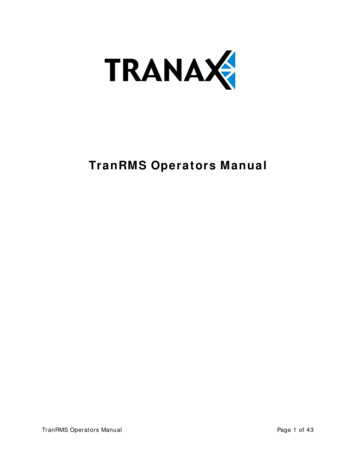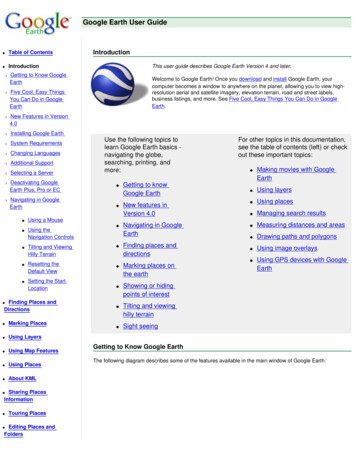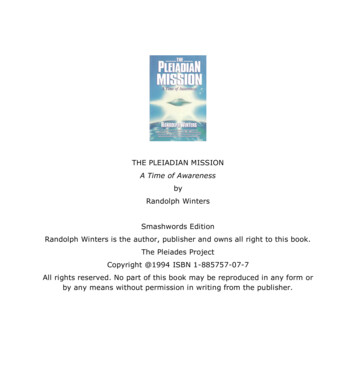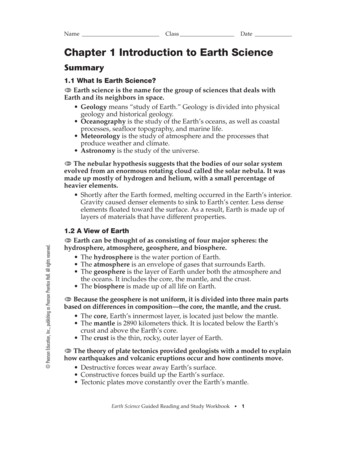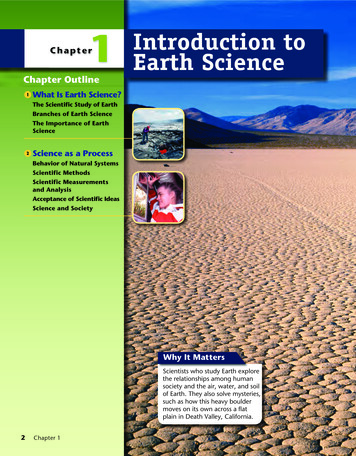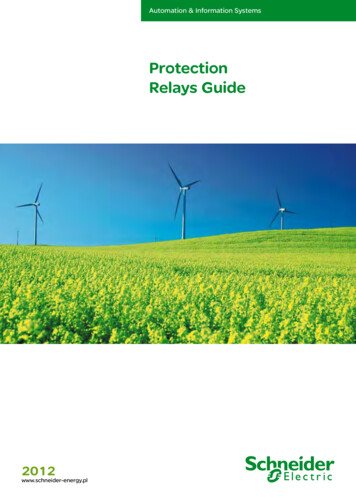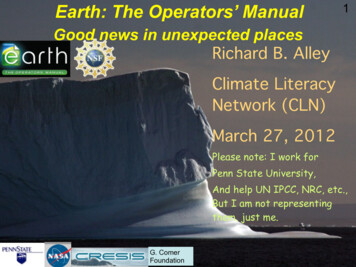
Transcription
Earth: The Operators’ Manual1Good news in unexpected placesRichard B. AlleyClimate LiteracyNetwork (CLN)March 27, 2012Please note: I work forPenn State University,And help UN IPCC, NRC, etc.,But I am not representingthem, just me.G. ComerFoundation
First hour shownnationwide onPBS last springFull three-hourversion in AprilStay tuned NSF Funded, TV, web, museum tour, book**Accessible, apolitical, authoritative, and a lot of fun**Streaming at www.earththeoperatorsmanual.com and PBSGeoff Haines-Stiles & Erna Akuginow, Passport to Knowledge2
3
4We get much good from energyuse, but tend to use so much wecause problems as we run out, andsuffer damaging price shocksbefore finding new sourcesWhale-oil production, gallonsDrake Well, 1859CostProduction“GRAND BALL GIVEN BY THE WHALES IN HONOROF THE DISCOVERY OF THE OIL WELLS INPENNSYLVANIA”, VANITY FAIR, 1861“ suggests that central bankscannot fully insulatetheir economies from theconsequences of oil-priceshocks ” S Leduc, K Sill, 2004, J.Monetary Econ. 51, 781Prices & Production over a complete Hubbert Cycle. 2004, Ugo nts/bardi/whaleoil/whaleoil.html Data from A. Starbuck, History of the American whale fishery,Seacaucus, N.J. 1878
5We’re heading toward repeating history 85% of energy use is from fossil fuelsWe’re using them 1 million times fasterthan nature saved them for usPublished estimates I’ve found: entirefrackable gas reserve 5 to 25 years oftotal US energy use (gas 1/4 of use now)Big energy-system change in 30 yearsvery difficult gas has much energy, many , NOT sustainable.
6High scientific confidence:If we burn, then learn, we will havechanged climate in ways that make ourgrandchildren’s lives much harderAnd risked really big price shocksIf we learn while we burn, we cansustainably have a better economy withmore jobs and greater national securityBarriers are not in science or engineering(the wisdom of Pogo comes to mind )
Id 9885767CO2 is rising, fossil fuels main cause: Bookkeeping (we see CO2 we emitin air and moving into ocean) No other source big enough(volcanoes 1-2% of human source) Fingerprints—dropping oxygen, 13Cand 14C show CO2 from burning ofsomething that was alive but has beendead a long time—fossil fuels.7If CO2 came out oftailpipes as horseploppies: 1 pound/mile for a typical car Would cover every road inUS an inch deep in 1 year(See “It’s us” in first hour of ETOM)
8Earth glowingto cool offCO2 blocking,warms“Color” in infrared(wavenumber cm-1)Harries et al., 2001, NatureBasis for expecting global warming: Is PHYSICS**Known for over a century**Refined by Air Force after WWII(operations, communications, and heatseeking missiles)**Confirmed by history**Observed today (satellites, etc.)
So is it warming?Iwasbornin1957,atthestartofcooling?9
10Igotmarriedin1980,atthestartofcooling?
11WemovedtoPennStatein1988,atthestartofcooling?
12Wetouredthewestin1997,atthestartofcooling?
?
14DaughterJanettoPSUin2005,atthestartofcooling?
hoseshortertrendsissignificant,butlongertrendis.
It is getting warmer (e.g., IPCC, 2007):16Thermometers (including outside cities, and analyzed by NOAA, andNASA, and British, and Berkeley, and )Thermometers in oceans, in ground, on balloons, and on satellites,analyzed in different ways by different groupsSnow and ice (temperature-sensitive times and places)—seasonalsnow, lake and river ice, seasonally frozen ground and permafrost,glaciers, etc.—and where creatures live and when they do thingsMany people are fooled byshort wiggles (the black lines)in the temperature history(GISTEMP, red), but thesignificant trend is WARMING(blue)—people lose money inVegas and on Wall Streetbased on the same confusion!
17How much of recentwarming is from CO2and othergreenhouse gases?Most likely answeris: more than all of it.We have cooled withsun-blockingparticles, sun hasdimmed a bit, yet wesee warming Blue Nature Only Pink Humans Nature Black DataThe warming occurring is not explained by nature.Changes are occurring as expected from early climatescience projections, including patterns such as upperstratospheric cooling with surface warming, and evenchanges in hydrologic cycle—climate science issuccessfully predictive as well as explanatory.
18Warming to come(world continuespast 2100 )Future warming could be largeChanges to date confirm our scientific understanding, whichshows future changes if we keep burning will be much largerthan past changes.
19Rear Admiral David Titley, Oceanographer ofthe Navy and Navigator of the Navy“. . . climate change, energy security, and economic stability areinextricably linked. Climate change will contribute to food and waterscarcity, will increase the spread of disease, and may spur orexacerbate mass migration.” US Pentagon QDR
20ProbabilitySome traffic,blah tunesNo traffic,greattunesLots of traffic,test of emergencybroadcast systemRun over bydrunk driverProblemsSuppose you have to drive somewhere. What are you likelyto encounter, and what do you plan for?
ProbabilityAir bags, crumple21zones, seat belts,Some traffic,kid seats,blah tunesinsurance,Mothers AgainstDrunk Driving,No traffic,Lots of traffic,more—realgreattest of emergency investment.tunesbroadcast systemRun over bydrunk driverProblemsSuppose you have to drive somewhere. What are you likelyto encounter, and what do you plan for?
22ProbabilityUN-IPCC(best estimate)Smalleror slowerchangesLargeror fasterchangesAbrupt climatechange; ice-sheetcollapse; so hotthat humanswould need airconditioning topersist on largeparts of Earth(Sherwood & Huber, PNAS,2010)ProblemsMy interpretation of probability ofvarious levels of future problems.
Maximum Available Energy: Sun 173,000 TW Wind 1220 TW Plants 166 TW Waves & currents 65 TW Geothermal 44 TW Human use today 15 TW Tides 4 TW Hydroelectric 1.9 TW23
asts,andrunning- overanduponthesamespace made,willbethetamingandharnessingofit.Discoveries and Inventions: A Lecture by AbrahamLincoln Delivered in 1860 (John Howell, San Francisco,1915).24
For Energy :25 Building a wind farm on windy parts ofdeserts and plains would generate 5x moreenergy than world use (On land that is not city,forest or ice, with enough wind to run at 20% capacity; Lu,McElroy and Kiviluoma, 2009, Global potential for windgenerated electricity, Proceedings of the National Academyof Sciences of the USA 106, 10,933-10,938) Some issues with batteries if a lot of wind isused, but wind is generally competitive now
26The US rate of windmillinstallation a centuryago, if repeated todaywith modern windturbines, would supply1/3 of WORLD energyuse from wind in 30years.Photo by Geoffrey Haines-Stiles forEarth: The Operators’ Manual, Texas
27Global humanenergy usecould besupplied bycoveringapproximatelythis area of atropical desertwith solar cellsconverting 10%of sunlight toelectricity.
d0.01%ofsun’senergywouldpowerhumanity.
29We aim to show howmuch good really isavailable here relating humantapped to naturalgeothermal power inNew Zealand.
From waves, currents,tides and ocean thermalenergy 30to cellulosic ethanol and otherbiofuels, including accountingfor the tradeoffs (here with JimMcMillan, National RenewableEnergy Lab).
31Economics consistently gives same answer:If you believe in traditional economics, withtraditional discount rate, and an economy thatcan grow a few percent per year foreverThen you still respond to climate changeNot with panic, but over 30 years or so(Nordhaus, etc.)This is really important, I believe—hard-nosedeconomics says respond!
If you care about national security, thePentagon says that you respond to this32How about jobs? Work ongoing, but papers Ifound indicate response gives more jobs, orat least similar numbers. (Paying “rent” topeople whose ancestors settled atop fossilfuels may not be job-optimal.)Golden rule: losers are especially poor peoplein hot places, and future people, who are notcausing the changesFailure to respond is unsustainable; responsecan be sustainable!
So, we can have a sustainablefuture, with a better economyproviding more jobs and greatersecurity while following the goldenrule If we decide we want it.
Earth: The Operators’ Manual Good news in unexpected places Richard B. Alley Climate Literacy Network (CLN) March 27, 2012 Please note: I work for Penn State University, And help UN IPCC, NRC, etc., Bu

